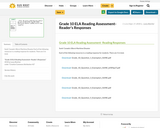
Sunk! Canada's Worst Maritime Disaster
Each of the following resources is a reading response for students. There are 5 in total.
- Subject:
- English Language Arts
- Material Type:
- Activity/Lab
- Assessment
- Homework/Assignment
- Date Added:
- 09/16/2018

Sunk! Canada's Worst Maritime Disaster
Each of the following resources is a reading response for students. There are 5 in total.
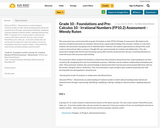
Outcome FP10.2 – Demonstrate an understanding of irrational numbers in both radical (including mixed radical) and exponent forms through: representing: identifying: simplifying: ordering: relating to rational numbers: applying exponent laws.
PART 1:
In groups of 5-6, create a project to demonstrate mastery of the above outcome. You may create a poster, PowerPoint, prezi, video, etc… if you have another idea, ask your teacher for approval. Create your project as if you are teaching this outcome to another student – what would they need to know and what examples would be useful?
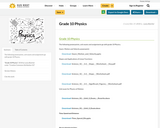
The following powerpoints, unit exams and assignments go with grade 10 Physics.

This assessment piece was from the first unit of a first time course my co-op teacher and I developed. The course teaches construction and computer assisted design through building guitars. For this project students were asked to create a guitar model based on the Fender Telecaster. It assessed skills we had been working on for about a month prior to this assessment. Their models for this particular assignment would have to be compared to exemplars and blueprints as accuracy is of extremely high importance when building a guitar. There was other projects leading up to the unit that assessed their technical as well as creative skills.
This is a 4 point rubric (unsatisfactory, emerging, proficient, and exceptional) and assess Drafting modules 27 and 28 that focus on interpreting blueprints and creating high quality models. The first of 7 C's this rubric assesses is Communication. Students are being assessed on their competency and literacy of CAD programs and how professionals would be communicating in the field. The second C this rubric covers is developing computer and digital technologies. Students, through completing this unit are using computers and digital resources to create products.
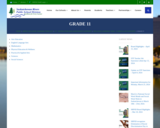
This comprehensive resource from Saskatchewan Rivers Public School Division includes units of study plus curricular and assessment resources for Grade 11 Arts Education, ELA, Physical Education and Wellness, Practical and Applied Arts, Mathematics, Sciences and Social Studies. Look for rubrics, unit plans, sample year plans (and templates), Treaty Education outcomes and indicators as well lots of other teacher resources. Some of the information is not available as a login is required.
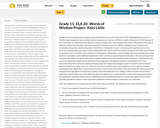
I designed this assessment piece during my internship to fit into our unit on the novel To Kill a Mockingbird by Harper Lee. This three part assignment was one that covered two outcomes; Outcome: CR 20.2, as well as Outcome: CC 20.1. Because of the combination of comprehend and respond as well as compose and create, students were able to fully explore their ideas in different mediums and situations and work towards the end goal in a new way. While reading the novel, students were continually writing down significant quotes in their Writer’s Notebooks in order to fully grasp the important parts of the novel. This was expanded upon when students would share their quotes with one another and discuss why they found them to be significant. This correlates to the competency of developing collaboration, and this collaboration was expanded upon when students were asked to talk to different individuals in their own lives to receive important life advice. This also enhanced their communication skills as students had to talk to multiple individuals for the second part of the assignment, and then interview one of the individuals in depth for the third part of the assignment. Through the process of creating their Life’s Little Instructions Book they had to be creative and expand upon their digital technologies in order to research and incorporate pearls of wisdom from other resources. The main reason for having this three-part assignment was to really get students thinking about the significance certain excerpts from the novel and how they relate to their lives today. By continuing with the assignment through different assessments (analysis, instruction book and story-telling), students become critical thinkers within the context of their own minds while also given the opportunity to really expand on an idea. Each assessment piece in this assignment combines student inquiry, collaboration and critical thinking which is an important aspect of 21st Century teaching. Overall the students really enjoyed the assignment and the products created were very well done!
Task: Your assignment is to create your own Life’s Little Instructions Book. Your booklet must contain the following:
1. Five (or more) pearls of wisdom from To Kill a Mockingbird.
2. Ten (or more) pearls of wisdom from wise people in your world. Consider asking your parents, grandparents, aunts, uncles, neighbors, teachers, coaches, etc.
3. Ten (or more) pearls of wisdom from research sources, including other novels, books, newspapers, websites, television shows, movies, song lyrics, and speeches.
4. Five (or more) pearls of your own. Consider what you have learned thus far in your life. What advice can you offer?
Reminder: Quotes can be philosophical (“Never cut what can be untied”), practical (“Always own a good dictionary”), or humorous (“Never eat yellow snow”).

In this module, students read, discuss, and analyze literary and nonfiction texts focusing on how central ideas develop and interact within a text. Students also explore the impact of authors’ choices regarding how to develop and relate elements within a text.
Find the rest of the EngageNY ELA resources at https://archive.org/details/engageny-ela-archive .

In this module, students read, discuss, and analyze literary and informational texts, focusing on how authors use word choice and rhetoric to develop ideas, and advance their points of view and purposes. The texts in this module represent varied voices, experiences, and perspectives, but are united by their shared exploration of the effects of prejudice and oppression on identity construction. Each of the module texts is a complex work with multiple central ideas and claims that complement the central ideas and claims of other texts in the module. All four module texts offer rich opportunities to analyze authorial engagement with past and present struggles against oppression, as well as how an author’s rhetoric or word choices strengthen the power and persuasiveness of the text.
Find the rest of the EngageNY ELA resources at https://archive.org/details/engageny-ela-archive .

In Module 11.3, students engage in an inquiry-based, iterative process for research. Building on work with evidence-based analysis in Modules 11.1 and 12.2, students explore topics that have multiple positions and perspectives by gathering and analyzing research based on vetted sources to establish a position of their own. Students first generate a written evidence-based perspective, which will serve as the early foundation of what will ultimately become a written research-based argument paper. The research-based argument paper synthesizes and articulates several claims using valid reasoning and relevant and sufficient evidence to support the claims. Students read and analyze sources to surface potential problem-based questions for research, and develop and strengthen their writing by revising and editing.
Find the rest of the EngageNY ELA resources at https://archive.org/details/engageny-ela-archive .

In this module, students read, discuss, and analyze literary texts, focusing on the authors’ choices in developing and relating textual elements such as character development, point of view, and central ideas while also considering how a text’s structure conveys meaning and creates aesthetic impact. Additionally, students learn and practice narrative writing techniques as they examine the techniques of the authors whose stories students analyze in the module.|
Find the rest of the EngageNY ELA resources at https://archive.org/details/engageny-ela-archive .
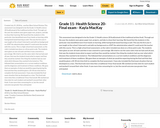
Created July 25, 2018 by , userSun West School Division
This assessment was designed to be the Grade 11 Health science 20 final(instead of the traditional written final). Through out the year the students were given paper test, projects, and labs to show their learning. We found that the students in this particular class benefitted more from hands on learning, while having book based learning as well. This was the first year it was taught at the school I interned in and with my background as a EMT the administration asked if I could assist the teacher with this course. This is a high school level assessment, so the rubric included was done on a three point scale. The students were given an over all mark and then it was covered to a percentage. We tried to use the same rubric that we had used all year, that way the students knew what to expect and how they would be marked. One thing the students had say over what which diseases they wanted to be tested on. This followed their presentations on a current medical conditions and the diagnoses and treatment of these conditions. We gave them an exemplar of what we would be expecting during the final and that they would be given a 20-30 min time limit to complete the final assessment. I have also included the final exam situation that we developed as a class. This final took more time then a traditional 3 hour final would. We worked out time slots for each student and worked it around their other finals. It was more time consuming for us, but the overall outcome was greater than anticipated.
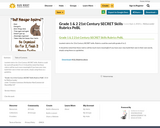
Leveled rubrics for 21st Century SECRET skills. Rubrics could be used with grades K to 2.
It should be noted that these rubrics will be much more meaningful if you have your class build their own in their own words, simply using these as a guideline.
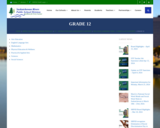
This comprehensive resource from Saskatchewan Rivers Public School Division includes units of study plus curricular and assessment resources for Grade 12 Arts Education, ELA, Physical Education and Wellness, Practical and Applied Arts, Mathematics, Sciences and Social Studies. Look for rubrics, unit plans, sample year plans (and templates), Treaty Education outcomes and indicators as well lots of other teacher resources. Some of the information is not available as a login is required.

In this 12th grade Extension Module, students can go deeper into analyzing arguments, as they outline, analyze, and evaluate the claims that Michelle Alexander makes in|The New Jim Crow: Mass Incarceration in the Age of Colorblindness, paying attention to her use of rhetoric to convey her ideas. Please note that this 12th grade Extension Module is an extra module that has been developed as part of the 12th grade ELA modules; grades 9-11 do not have additional or extension modules. A full year of curriculum is available for 12th grade through modules 1-4.
Find the rest of the EngageNY ELA resources at https://archive.org/details/engageny-ela-archive .

Module 12.1 includes a shared focus on text analysis and narrative writing. Students read, discuss, and analyze two nonfiction personal narratives, focusing on how the authors use structure, style, and content to craft narratives that develop complex experiences, ideas, and descriptions of individuals. Throughout the module, students learn, practice, and apply narrative writing skills to produce a complete personal essay suitable for use in the college application process.
Find the rest of the EngageNY ELA resources at https://archive.org/details/engageny-ela-archive .

Over the course of Module 12.2, students practice and refine their informative writing and speaking and listening skills through formative assessments, and apply these skills in the Mid-Unit and End-of-Unit Assessments as well as the Module 12.2 Performance Assessment. Module 12.2 consists of two units: 12.2.1 and 12.2.2. In 12.2.1, students first read “Ideas Live On,” a speech that Benazir Bhutto delivered in 2007. Next, students analyze the complex ideas and language in Henry David Thoreau’s essay, “Civil Disobedience.”
Find the rest of the EngageNY ELA resources at https://archive.org/details/engageny-ela-archive .

In Module 12.3, students engage in an inquiry-based, iterative research process that serves as the basis of a culminating research-based argument paper. Building on work with evidence-based analysis in Modules 12.1 and 12.2, students use a seed text to surface and explore issues that lend themselves to multiple positions and perspectives. Module 12.3 fosters students’ independent learning by decreasing scaffolds in key research lessons as students gather and analyze research based on vetted sources to establish a position of their own. Students first generate a written evidence-based perspective, which serves as the early foundation of what will ultimately become their research-based argument paper.
Find the rest of the EngageNY ELA resources at https://archive.org/details/engageny-ela-archive .

In this 12th grade module, students read, discuss, and analyze four literary texts, focusing on the development of interrelated central ideas within and across the texts. |The mains texts in this module include|A Streetcar Named Desire|by Tennessee Williams, “A Daily Joy to Be Alive” by Jimmy Santiago Baca, “The Overcoat” by Nikolai Gogol, and|The Namesake|by Jhumpa Lahiri. As students discuss these texts, they will analyze complex characters who struggle to define and shape their own identities. The characters’ struggles for identity revolve around various internal and external forces including: class, gender, politics, intersecting cultures, and family expectations.|
Find the rest of the EngageNY ELA resources at https://archive.org/details/engageny-ela-archive .
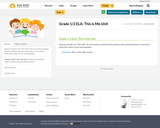
Resource includes unit "This is Me". This unit includes a booklet that the students make about themselves. It covers their family, likes, wishes, future and autographs.
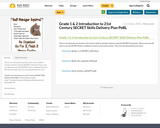
This is a six week plan to introduce 21st century skills to younger students using the SECRET framework. Please note you will want to use the SECRET Posters and Book List also in the resource bank. (They are also attached here for ease.)